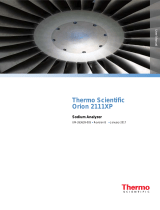Page is loading ...

Thermo Scientific Orion
2395 Phosphate Analyzer
270118-001 • Revision B • August 2015
User Manual


Contents
Section 1 ....................................................................................................................... 5
Operating Principle ...................................................................................................... 5
Analyzer Operation ...................................................................................................................... 5
Section 2 ....................................................................................................................... 7
Analyzer Installation ..................................................................................................... 7
Mechanical Description ................................................................................................................ 7
Installation Requirements ............................................................................................................ 8
Terminal Block Interconnection.................................................................................................... 9
Electrical Installation .................................................................................................................. 10
Section 3 ..................................................................................................................... 11
Initialization Steps ...................................................................................................... 11
Section 4 ..................................................................................................................... 15
Menu Navigation ......................................................................................................... 15
Turning the Analyzer On ............................................................................................................ 15
Start Analyzer ............................................................................................................................ 16
Configuring the Analyzer ........................................................................................................... 16
Setting up Measurement Parameters ........................................................................................ 17
Configuring Transmission .......................................................................................................... 18
Configuring Control Settings ...................................................................................................... 20
Return to the Reading Screen ................................................................................................... 24
Calibration Settings .................................................................................................................... 25
Loading Factory Calibration ....................................................................................................... 25
Performing a Manual Calibration ............................................................................................... 26
Reagents ................................................................................................................................... 27
Section 5 ..................................................................................................................... 29
Analysis Cycle Sequence .......................................................................................... 29
Section 6 ..................................................................................................................... 31
Error Messages ........................................................................................................... 31
Section 7 ..................................................................................................................... 33
Preventative Maintenance .......................................................................................... 33
Semi-Annual Maintenance ......................................................................................................... 33
Annual Maintenance .................................................................................................................. 33
Bi-Annual Maintenance .............................................................................................................. 33
Maintenance schedule ............................................................................................................... 34
Section 8 ..................................................................................................................... 35
Troubleshooting ......................................................................................................... 35
Section 9 ..................................................................................................................... 37
Specifications ............................................................................................................. 37

Section 10.................................................................................................................... 39
Accessories and Spare Parts .................................................................................... 39
Section 11.................................................................................................................... 41
Modbus Settings ......................................................................................................... 41
Section 12.................................................................................................................... 45
Procedure to Disconnect the Analyzer ..................................................................... 45
Section 13.................................................................................................................... 47
Customer Service ....................................................................................................... 47
Notice of Compliance ................................................................................................................. 47
Declaration of Conformity ........................................................................................................... 48
Terms and Conditions ................................................................................................................ 49
Contact Information ........................................................................................................... 49
Minimum Order ................................................................................................................. 49
Rush Orders ..................................................................................................................... 49
Returning Goods ............................................................................................................... 49
Hazardous Materials ......................................................................................................... 50
Restocking Charge ........................................................................................................... 50
Short Shipments ............................................................................................................... 50
Force Majeure .................................................................................................................. 50
Warranty ........................................................................................................................... 50

2395 Phosphate Analyzer Thermo Scientific Orion | 5
1
Operating Principle
Analyzer Operation
Thermo Scientific™ Orion™ 2395 Phosphate Process Analyzer operates using a Flow Injection
Analysis (FIA) system coupled with an optical sensor to measure ortho or reactive phosphate.
Sample containing the reactive phosphate is initially mixed with a reagent consisting of
ammonium molybdate in a strongly acidic medium. This produces a heteropoly acid complex
known as vanadomolybdophosphoric acid. The yellow color formed by the molybdovanadate
SECTION 1

Section 1
|
Operating Principle
6 | Thermo Scientific Orion 2395 Phosphate Analyzer
phosphoric acid is proportional to the concentration of reactive phosphate.
In general, FIA involves the rapid injection of the sample under continuous flow. Sample is
mixed with the reagent before entering the detection system.
During this process, the sample disperses and mixes with the reagent to form a homogenous
solution, which is delivered to the measurement cell. Inside the measurement cell, the sample-
reagent mixture is held until the reaction is complete and the absorbance signal is acquired.
The reacted solution is displaced by the next sample entering the measurement cell. As the
new sample-reagent mixture enters it rinses the cell to ensure there is no cross-contamination.
FIA is suitable for highly reproducible analyses with low reagent consumption, promoting a high
sample throughput and minimizing contamination.

2395 Phosphate Analyzer Thermo Scientific Orion | 7
2
Analyzer Installation
Mechanical Description
The analyzer consists of a durable light weight plastic cabinet, containing separate electronics
and fluidics compartments. The enclosure is IP-56 rated with dimensions of 13.1 in x 16.3 in x
5.7 in (333 mm x 413 mm x 145 mm) and can be wall or panel mounted on a flat surface. The
analyzer cabinet has three standardized 1/2" cable glands and terminal strips for connecting to
a power source and communication cables.
SECTION 2
1. Electronic Module
2. Overflow
3. Dosing Pump
4. Measurement cell
5. FIA System
6. Standard
7. Reagent

Section 2
|
Analyzer Installation
8 | Thermo Scientific Orion 2395 Phosphate Analyzer
Installation Requirements
To ensure optimal performance of the Orion 2395 phosphate continuous analyzer, it is critical to
install it correctly. The following steps must be followed:
1. CAUTION: In addition to the specific requirements listed in this manual, main power and
product installation must be in accordance governing national, local electric codes and
safety regulations.
2. After the removing the analyzer from the packaging, confirm that there is no damage
resulting from transportation.
3. Follow the recommendations below:
a. Install the analyzer in an easily-accessible location, free of vibrations, smoke,
corrosive fumes, water spray and chemical substances.
b. CAUTION: Direct sunlight may cause the internal temperature of the equipment to
rise, risking damage to the analyzer and its reagents. We recommend using a
protective covering with the analyzer.
c. CAUTION: Confirm the cable glands are dry and holding their respective
interconnection cables tightly. Moisture will decrease the impedance, causing
measurement errors. If there is a small gap, strap the cable with high-heat tape until
you get a perfect grip on the cable gland. Never use silicone. This procedure will help
preserve the protective characteristics of the housing (IP-56).
d. Periodically replace the O-ring seals to ensure a good seal in the housing. Make sure
the lids are securely fastened, to ensure a good seal.
WARNING: Never install the analyzer near pumps or motors with industrial loads (source of
electromagnetic discharge), or on the same network that feeds the motor. This may cause
equipment malfunction or damage to the unit.
4. Proceed to connect the wiring from the power cord to the terminals using the Terminal
Block Interconnection table on Page 9 and the Electrical Installation Wiring Diagram
on Page 10.
5. Inspect all wiring to ensure the connections are correct.
6. Check that power supply is stable. The analyzer will only operate correctly on a
voltage rating between 90 to 240 VAC (50/60Hz). Confirm that the correct voltage is
being supplied.
7. The lack of proper grounding can cause serious damage to the equipment. The
voltage between ground and neutral cannot exceed 5V. If it is above this threshold,
there is bad ground or an unbalanced load. In this case, turn the circuit breakers on at
the electric power switch panel after checking voltage between ground and neutral.

Analyzer Installation
|
Section 2
2395 Phosphate Analyzer Thermo Scientific Orion | 9
WARNING: The supply of control valves, solenoids, alarms and other components should be
directly connected to the electrical panel and never on the same circuit as the analyzer (phase
recovery).
WARNING: The power supply cables must be physically isolated with cable glands, separate
from the other cables. Wiring for the 4-20mA and digital signals (RS-485) must be in a
separate conduit. Solenoid cables must also be separated in their own conduit. If needed the
solenoid and power cable may be placed through the same conduit.
Terminal Block Interconnection
Posts Connections
1
Grounding
2 and 3
Power supply 90 to 240 VAC (50/60Hz)
4 and 5
S1-Alarm or Control set point
6 and 7
S2-Alarm or Control set point
8 and 9
External control-Remote control for Stand-by
10,11 and 12
Digital communication output RS-485
13 and 14
Current output 4-20mA - Channel 1
15 and 16
Current output 4-20mA - Channel 2
Fuses
F1 = General (1.6 A / 250 V) - slow blow
F2= Set. Point (SP1) - 1A/250 V - fast blow
F3= Set. Point (SP2) - 1A/250 V - fast blow
NOTE: The External Command (Terminal Posts 8 and 9) is used when the equipment needs to
be placed in Stand-by (for example, in the case of a process interruption).

Section 2
|
Analyzer Installation
10 | Thermo Scientific Orion 2395 Phosphate Analyzer
Electrical Installation
NOTE 1: It is important to use separate cables and phases for equipment and control valves or
alarms.
NOTE 2: Cable shield 3 (terminal 12) should be installed on the terminal block connector only.

2395 Phosphate Analyzer Thermo Scientific Orion | 11
3
Initialization Steps
SECTION 3
Standard
bottle
Reagent
bottle
Tubing
Cap assembly
Analysis drain
Overflow drain

Section 3
|
Initialization Steps
12 | Thermo Scientific Orion 2395 Phosphate Analyzer
1. Install tubing at the overflow drain and a collector or funnel at the drain just below the
analysis module. Leave the analysis drain and the overflow drain "open" to prevent back
flow. The solution exiting through the overflow drain is pure process sample which can be
returned to the process stream, if desired. Analysis flow rate is 40 mL per reading. The
analysis drain must be discarded as it contains both process sample and reagents/residue.
2. Taking the reagent and standard bottles, remove each of the caps. Identify the tubing and
cap assembly corresponding to the reagent and standard. Insert the tubing with check
valve (white pieces at the ends of the hoses) into each respective bottle and tighten the
caps.
3. Place the reagent and standard bottles in the analyzer reagent compartment.
4. Connect the process sample line to the sample inlet ½” NPT fitting on the base of the
Overflow cell. Confirm there are no leaks. Measure flow with a beaker at the over flow drain
outlet. The sample flow should be 70 mL/minute.
5. Tighten the four screws on the dosing pump (they are shipped loose).
6. Make sure that the turbidity of the process does not exceed 20 NTU.
7. Connect the analyzer to electrical power. After startup the analyzer will show the date
and time screen which will then proceed to the reading screen.
Overflow
cell
Process sample inlet ½” NPT
WARNING: DO NOT invert the bottles.

Initialization Steps
|
Section 3
2395 Phosphate Analyzer Thermo Scientific Orion | 13
8. Access SETUP mode and configure the INDICATION menu options at analyzer menu
(see page 16 – Configuring the analyzer).
9. Access SETUP mode and configure measure at analyzer menu (see page 16 –
Configure the analyzer).
10. Access the SETUP mode and adjust transmission values (see page 18 - Configure
Transmission).
11. Access reagents mode and refill hoses (see page 27–Reagents).
12. Let the analyzer acquire measurements for at least 2 hours.
13. Tighten the four screws on the dosing pump again.
14. Access to CALIBRATE mode and perform a manual calibration (see page 26 –
Performing manual calibration).
15. The analyzer is ready for on-line analysis of sample.

Section 3
|
Initialization Steps
14 | Thermo Scientific Orion 2395 Phosphate Analyzer

2395 Phosphate Analyzer Thermo Scientific Orion | 15
4
Menu Navigation
Turning the Analyzer On
Menus are designed for easy navigation and operation.
To enter or change data, the menu always provides flashing display options.
In order to access these options, press the SELECT and ENTER keys.
The BACK key is used to change options or correct unwanted data (it always returns to the
previous menu options).
When powering up the analyzer, the model and revision of software are indicated on the
display.
SECTION 4

Section 4
|
Menu Navigation
16 | Thermo Scientific Orion 2395 Phosphate Analyzer
Start Analyzer
Note: During the menu navigation the analyzer continues to perform the measurement routine. Only if the analyzer is
placed in STAND BY will the measurement routine stop.
Type passcode 220. Press and hold enter for 5 seconds to accept the password.
Configuring the Analyzer
The configuration step allows preferences for the measurement to be selected. This includes
preferred units, preferred parameter output, resolution, calibration point value as well as time
between calibrations and analysis.
Setting up language, date and time:
Reading Screen
Press the menu key to access configuration
screen or standby key to put analyzer in stand-by
mode
Configuration screen
Enter passcode 220 to access setup screen
Setup screen
Press indicat. key
Select language
Reading Screen
Adjust date and time

Menu Navigation
|
Section 4
2395 Phosphate Analyzer Thermo Scientific Orion | 17
Setting up Measurement Parameters
Configuration screen
Enter passcode 220 to access setup screen
Setup screen
Press measure key
Select measure unit
Select measure parameter
Select measure resolution
Configure the standard - value between 5 to 50 ppm
Reading Screen
Configure calibration frequency - time between 24 to 72 hours
Configure period between each measure - time between 0 to 45
minutes

Section 4
|
Menu Navigation
18 | Thermo Scientific Orion 2395 Phosphate Analyzer
Configuring Transmission
The transmission configuration section allows the analog outputs, and RS485 to be configured.
BURN-OUT function allows an analog output either 4mA or 20mA signal to be selected. During
a failure mode the selected signal is transmitted to alert the control room of the analyzer status.
Swap float Point is used in MODBUS communication protocol to allow information in registers
to be swapped for communication between the RS485 of the analyzer and the inlet of a PLC.
Configuration screen
Enter passcode 220 to access setup screen
Setup screen
Configure first analog output
Configure 4mA value point
Configure 20mA value point
Configure 4-20mA output
Reading Screen

Menu Navigation
|
Section 4
2395 Phosphate Analyzer Thermo Scientific Orion | 19
This screen appears only if output
is set for control
Configure second analog output
Configure digital output

Section 4
|
Menu Navigation
20 | Thermo Scientific Orion 2395 Phosphate Analyzer
Configuring Control Settings
In control settings, the set point and Pulse Width Modulation (PWM) is configured.
Pulse Width Modulation, or PWM, is a technique for getting analog results in a digital mode.
Digital control is used to create a square wave, a signal switched between on and off. This on-
off pattern can simulate voltages in between full on (5 Volts) and off (0 Volts) by changing the
portion of the time the signal spends on versus the time that the signal spends off. The duration
of "on time" is called the pulse width. To obtain varying analog values, the pulse width can be
changed, or modulated. Repeating this on-off pattern rapidly will result in a signal that appears
as a steady voltage between 0 and 5v. This is a PWM signal.
Configure first control
Configuration screen
Enter passcode 220 to access setup screen
Setup screen
Reading Screen
/












